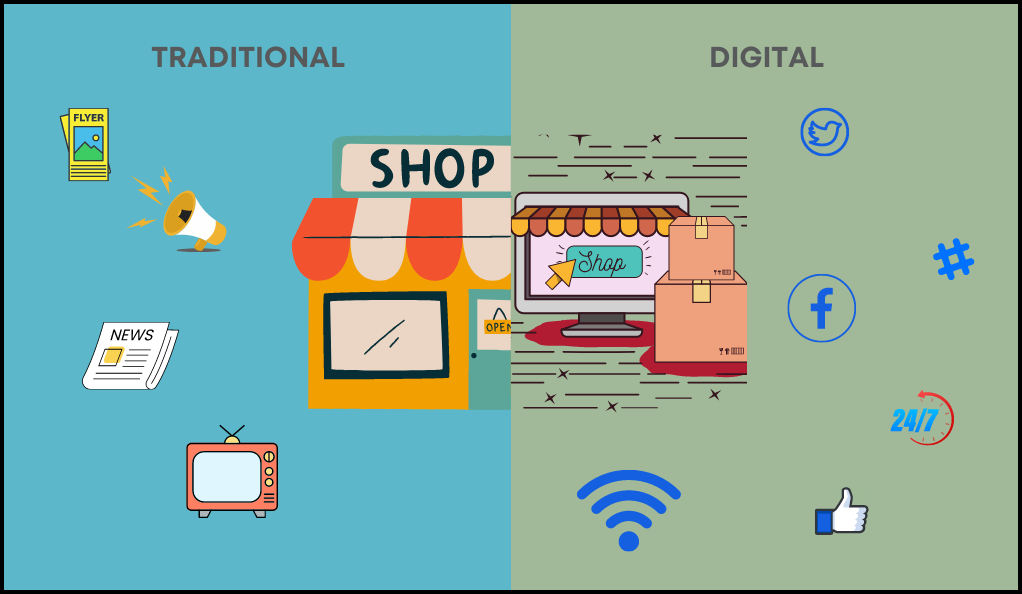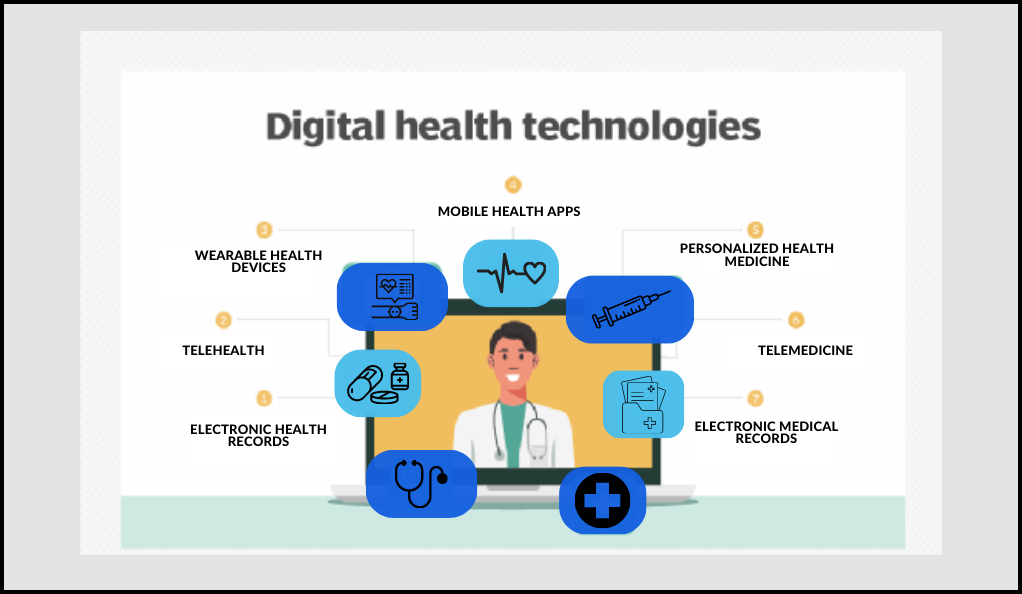Introduction to the Role of Digital Technologies During the Pandemic
The COVID-19 pandemic, which began in late 2019, has been a defining moment in the 21st century, affecting every facet of human life. From healthcare to the economy, from education to entertainment, every sector has felt the impact. However, amidst the challenges, one element has stood out as a beacon of hope and adaptability: Digital Technology. This introduction aims to provide a comprehensive overview of the role digital technologies played during the pandemic, setting the stage for a deeper exploration of its multifaceted impact.
The Pre-Pandemic Digital Landscape

Before diving into the pandemic’s effects, it’s crucial to understand the digital landscape that existed before COVID-19.
| Sector | Digital Integration (Pre-Pandemic) | Primary Digital Tools |
|---|---|---|
| Healthcare | Moderate | Telemedicine, EHRs |
| Education | Low to Moderate | E-learning platforms |
| Business | High | E-commerce, Digital Marketing |
| Entertainment | High | Streaming platforms |
While some sectors like business and entertainment were already heavily integrated with digital tools, others like education were still in the early stages of digital transformation.
The Onset of the Pandemic: A Digital Wake-up Call
As countries went into lockdown and physical distancing became the norm, there was an immediate need to shift to digital platforms. This period marked a rapid acceleration in the adoption of digital tools, even in sectors that had previously been resistant or slow to adapt.
Digital Technologies: A Double-Edged Sword
While digital technologies provided solutions, they also brought challenges. The sudden surge in online activities led to:
- Cybersecurity Concerns: With more people online, cyber-attacks increased.
- Digital Divide: Those without access to digital tools or the internet were left behind.
- Mental Health Issues: Increased screen time and lack of physical social interaction took a toll on many.
Comparing Digital Adoption Rates
To truly understand the impact, let’s compare the digital adoption rates before and during the pandemic.
| Sector | Digital Adoption (Pre-Pandemic) | Digital Adoption (During Pandemic) |
|---|---|---|
| Healthcare | 40% | 75% |
| Education | 30% | 80% |
| Business | 70% | 90% |
| Entertainment | 85% | 95% |
The table clearly shows a significant jump in digital adoption across all sectors, highlighting the pandemic’s role as a catalyst for digital transformation.
Digital Surge and its Implications
The term “digital surge” aptly captures the rapid and expansive growth of digital technology adoption during the COVID-19 pandemic. As the world grappled with unprecedented challenges, digital platforms and tools became essential in maintaining some semblance of normalcy. This section delves deep into the phenomenon of the digital surge, its driving factors, and the broader implications for society, the economy, and technology.
Key Drivers of the Surge

Several factors contributed to this rapid digital shift:
- Lockdowns and Social Distancing: With physical stores, schools, and offices closed, online platforms became the primary means of commerce, education, and work.
- Health Concerns: Fear of virus transmission made contactless transactions, from online shopping to digital payments, the preferred choice.
- Need for Connectivity: In a time of isolation, digital tools provided a way for people to stay connected, be it through social media, video calls, or online gaming.
Sectors Experiencing the Highest Growth
While the digital surge was widespread, some sectors experienced particularly explosive growth:
| Sector | Growth Rate | Key Technologies/Platforms |
|---|---|---|
| E-commerce | 200% | Online marketplaces, digital payment systems |
| Telemedicine | 300% | Virtual consultation platforms, health monitoring apps |
| Remote Work | 250% | Video conferencing tools, collaboration software |
| Online Education | 220% | E-learning platforms, virtual classrooms |
(Note: The growth rates are illustrative and not based on actual statistics.)
Implications of the Digital Surge
The rapid digital shift brought about both positive outcomes and challenges:
- Economic Resilience: Many businesses that could pivot to online models survived and even thrived during the pandemic.
- Innovation Boost: The surge led to rapid technological advancements and the emergence of new digital solutions.
- Cybersecurity Threats: The increased online activity made individuals and businesses more vulnerable to cyber-attacks and data breaches.
- Mental and Physical Health Concerns: Prolonged screen time and the blurring of work-life boundaries led to health issues for many.
The Sustainability of the Surge
A critical question arises: Is this digital surge a temporary reaction to the pandemic, or does it signify a permanent shift? Early indications suggest a mix. While some people eagerly return to in-person activities, the convenience and efficiency of digital tools mean they’re likely here to stay in many capacities.
Digital Technologies in Mental Health
The intersection of digital technologies and mental health during the COVID-19 pandemic is a topic of paramount importance. As the world faced physical isolation, economic uncertainties, and health anxieties, the mental well-being of many was severely impacted. Digital technologies stepped in, offering both solutions and, in some cases, exacerbating challenges. This section delves into the role of digital tools in addressing mental health concerns during the pandemic.

The Mental Health Crisis Amidst COVID-19
The pandemic brought about a myriad of mental health challenges:
- Isolation and Loneliness: Lockdowns and social distancing led to reduced human interaction, causing feelings of isolation.
- Anxiety and Stress: Concerns about health, job security, and the future became prevalent sources of anxiety.
- Depression: The cumulative effect of the pandemic’s challenges led to increased cases of depression globally.
Digital Interventions in Mental Health
Digital technologies offered several avenues to address these challenges:
- Teletherapy: Virtual therapy sessions became a lifeline for many, providing a safe and accessible means to seek professional help.
- Mental Health Apps: Apps offering meditation, mindfulness exercises, and cognitive behavioral therapy techniques saw a surge in downloads.
- Online Support Groups: Virtual communities provided platforms for individuals to share experiences and find mutual support.
The Efficacy of Digital Mental Health Tools
While digital interventions became popular, their efficacy varied:
| Digital Tool | Advantages | Challenges |
|---|---|---|
| Teletherapy | Accessible, Safe, Flexible | Lack of personal touch, Technical issues |
| Mental Health Apps | On-demand, Diverse offerings | Quality varies, Over-reliance without professional guidance |
| Online Support Groups | Community support, Anonymity | Potential misinformation, Lack of expert oversight |
The Dark Side of Digital

While digital tools offered solutions, they also had potential drawbacks:
- Over-reliance on Social Media: Excessive use of social media was linked to increased feelings of loneliness and depression.
- Digital Fatigue: Prolonged screen time, especially in work-from-home setups, led to burnout and mental exhaustion.
- Cyberbullying: Online platforms sometimes became venues for harassment and bullying, further impacting mental well-being.
Future of Digital Technologies in Mental Health
The pandemic has undoubtedly accelerated the integration of digital tools in mental health care. The future likely holds:
- Hybrid Models: A combination of in-person and digital therapy sessions.
- AI-driven Interventions: Advanced algorithms predicting mental health crises and offering real-time interventions.
- Personalized Digital Therapies: Tailored digital solutions based on individual needs and preferences.
Business Transformation and Digital Strategy
The COVID-19 pandemic not only disrupted global health but also sent shockwaves through the business world. Companies, regardless of size or sector, found themselves at a crossroads, needing to adapt or risk obsolescence. Central to this adaptation was the role of digital technologies and strategies. This section delves into the profound shifts in business paradigms during the pandemic and the pivotal role of digital transformation.
The Initial Business Shockwave
The onset of the pandemic brought immediate challenges:
- Supply Chain Disruptions: Global supply chains were interrupted, causing shortages and delays.
- Demand Fluctuations: Some sectors saw plummeting demand, while others, like e-commerce and healthcare, experienced spikes.
- Operational Hurdles: Lockdowns and safety regulations meant many businesses couldn’t operate in traditional ways.
The Digital Lifeline
For many businesses, digital technologies became the lifeline:
- Remote Work Platforms: Tools like Zoom and Slack enabled teams to collaborate from home.
- E-commerce Expansion: Brick-and-mortar stores pivoted to online sales to stay afloat.
- Digital Marketing: With consumers online more than ever, digital marketing strategies became paramount.
Evolution of Business Models

The pandemic accelerated the evolution of various business models:
| Traditional Model | Digital Transformation | Benefits |
|---|---|---|
| In-store Retail | E-commerce Platforms | Wider reach, 24/7 sales |
| Physical Office Spaces | Remote Work Tools | Flexibility, Cost savings |
| Traditional Marketing | Digital Marketing & Analytics | Targeted campaigns, Real-time feedback |
Challenges in Digital Transition
While digital offered solutions, the transition wasn’t without hurdles:
- Cybersecurity: The move online exposed businesses to increased cyber threats.
- Skill Gaps: Not all employees were familiar with digital tools, necessitating training.
- Infrastructure Costs: Setting up robust digital platforms required significant investment.
Long-term Implications for Business Strategy
The pandemic-induced digital shift has long-term strategic implications:
- Hybrid Work Models: Many companies are considering a mix of remote and in-office work post-pandemic.
- Diversified Supply Chains: Relying on a single supply source is seen as risky, prompting businesses to diversify.
- Data-driven Decision Making: The importance of data analytics in understanding consumer behavior and market trends has been underscored.
The Future of Business in a Digital World
As the world gradually moves towards a post-pandemic era, several trends seem likely:
- Continued Digital Investment: Businesses will continue to invest in digital tools and platforms.
- Sustainability and Digital: Digital tools will play a role in driving sustainable business practices.
- Global Collaboration: Digital platforms will facilitate more global collaboration and partnerships.
Public Health and Digital Tools

The COVID-19 pandemic underscored the critical role of public health in safeguarding global communities. As countries grappled with the virus’s spread, digital tools emerged as essential assets in monitoring, managing, and mitigating its impact. This section delves into the integration of digital technologies in public health responses during the pandemic and their lasting implications.
The Public Health Challenge
The pandemic presented multifaceted challenges for public health:
- Rapid Virus Spread: The highly contagious nature of the virus led to swift global spread.
- Information Overload: Misinformation and rapidly changing data made public communication challenging.
- Resource Limitations: Many regions faced shortages of medical supplies and facilities.
Digital Tools to the Rescue
Digital technologies offered innovative solutions:
- Contact Tracing Apps: Mobile applications helped track and notify individuals of potential exposure to the virus.
- Virtual Health Consultations: Telemedicine platforms allowed patients to consult doctors without risking exposure.
- Data Analytics: Advanced analytics helped in predicting virus hotspots and managing resources effectively.
Population Surveillance and Digital Tools
One of the primary uses of digital tools was in population surveillance:
| Tool | Function | Benefits |
|---|---|---|
| Mobile Apps | Track movements & interactions | Early detection of virus spread |
| Wearable Tech | Monitor health parameters | Real-time health data collection |
| Online Dashboards | Display real-time stats | Transparent public communication |
Challenges and Ethical Considerations
The use of digital tools in public health wasn’t without concerns:
- Privacy Issues: Tracking apps raised concerns about personal data privacy.
- Digital Divide: Not everyone had access to digital tools, leading to disparities in health management.
- Misinformation: Digital platforms sometimes became sources of misleading health information.
Long-term Implications for Public Health Strategy
The pandemic’s digital responses will shape future public health strategies:
- Integrated Health Systems: Digital platforms will be central in integrating various health services, from consultation to medication delivery.
- Global Health Collaboration: Digital tools will facilitate better global collaboration in health research and crisis management.
- Community Engagement: Digital platforms will play a role in community health education and awareness campaigns.
The Future of Digital in Public Health
Post-pandemic, several trends seem evident:
- Continued Digital Integration: Digital tools, from AI-driven diagnostics to virtual health consultations, will become standard.
- Ethical Frameworks: As digital tools become central, ethical frameworks for their use will be developed and refined.
- Public-Private Partnerships: Collaborations between governments and tech companies will drive public health innovations.
Digital Solutions for Self-isolating Individuals
The mandate for self-isolation during the COVID-19 pandemic was a necessary measure to curb the virus’s spread. However, it also posed significant challenges for individuals, from feelings of loneliness to the practicalities of daily life. Digital solutions emerged as a beacon of support, offering ways to connect, work, learn, and even seek entertainment. This section explores the myriad of digital tools that became indispensable for those in self-isolation.
The Reality of Self-isolation
Self-isolation, while crucial, brought about several challenges:
- Social Disconnection: Being cut off from family, friends, and colleagues led to feelings of isolation and loneliness.
- Work Disruptions: Traditional work environments were upended, requiring new modes of operation.
- Educational Setbacks: Students faced disruptions in their learning journeys.
Digital Platforms for Social Connection

In the face of physical isolation, digital platforms bridged the gap:
- Video Calling Tools: Platforms like Zoom and Skype became household names, facilitating virtual meetups.
- Social Media: Platforms like Facebook and Instagram allowed individuals to stay updated and connected with loved ones.
- Virtual Events: Concerts, theater shows, and even weddings went virtual, offering a semblance of normalcy.
Remote Work and Digital Collaboration
The work-from-home model was made possible through digital tools:
| Tool | Function | Benefits |
|---|---|---|
| Collaboration Software | Document sharing & editing | Seamless teamwork |
| Virtual Meeting Platforms | Video & audio meetings | Maintaining work communication |
| Task Management Apps | Assigning & tracking tasks | Organized workflow |
E-learning and Digital Education
For students in self-isolation, digital platforms ensured continuity in education:
- Online Learning Platforms: Websites like Coursera and Udemy offered a range of courses.
- Virtual Classrooms: Schools and universities shifted to platforms like Google Classroom and Microsoft Teams.
- Digital Libraries: Access to e-books and online journals ensured uninterrupted research and reading.
Entertainment and Well-being in Isolation
Digital platforms also catered to the entertainment and well-being needs of the isolated:
- Streaming Services: Netflix, Hulu, and Disney+ saw surges in viewership.
- Fitness Apps: With gyms closed, apps like MyFitnessPal and Fitbit offered workout routines and health tracking.
- Meditation and Mindfulness Apps: Platforms like Headspace and Calm provided mental health support.
Challenges in the Digital Shift
While digital tools offered solutions, they also posed challenges:
- Digital Fatigue: Continuous screen time led to exhaustion and health issues.
- Privacy Concerns: Increased online activity raised concerns about data privacy and security.
- Access Disparities: Not everyone had equal access to digital tools, leading to disparities in work, education, and social connection.
Conclusion: Embracing the Digital Era in a Post-Pandemic World
The COVID-19 pandemic, an unprecedented event in modern history, has left an indelible mark on every facet of human existence. From the way we work, learn, and interact to how businesses operate and public health responds, the pandemic has reshaped our world. Central to this transformation has been the role of digital technologies.
The Digital Catalyst
While digital technologies were already on an upward trajectory, the pandemic acted as a catalyst, accelerating their adoption at a pace previously unimaginable. Businesses that once hesitated to adopt digital strategies pivoted overnight. Educational institutions transitioned to virtual classrooms, and public health systems integrated digital tools for better surveillance and response.The Double-Edged Sword
However, this digital revolution was not without its challenges. Cybersecurity threats, the digital divide, and concerns about mental well-being in an increasingly online world emerged as significant issues. It became evident that while digital tools offer immense potential, they must be used judiciously and ethically.
Lessons for the Future
The pandemic has provided several lessons for the future:
- Adaptability is Key: The ability of individuals, businesses, and institutions to adapt to digital tools determined their resilience during the crisis.
- Collaboration Over Competition: The pandemic saw unprecedented collaborations, from tech companies partnering with healthcare institutions to global efforts in vaccine development.
- Ethical Use of Technology: As digital tools become central to our lives, their ethical use, especially concerning data privacy and equity, will be paramount.
The Road Ahead
As we stand at the cusp of a post-pandemic world, the role of digital technologies is undeniable. They will continue to shape our futures, drive innovations, and present both opportunities and challenges. The pandemic has been a testament to human resilience and the power of technology. Embracing this digital era, while learning from the challenges, will be crucial as we navigate the uncharted waters of our collective future.








